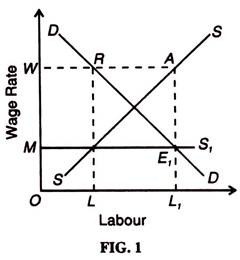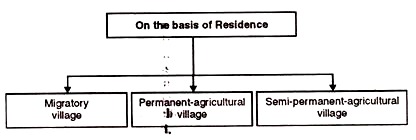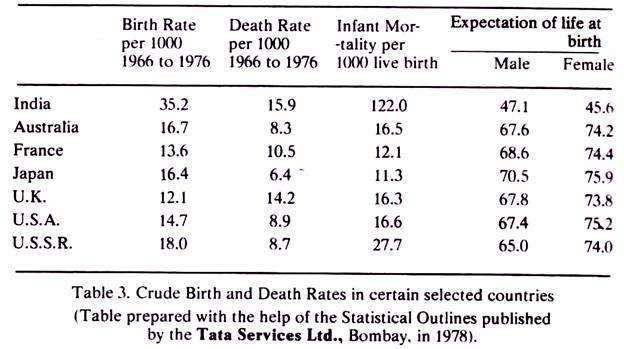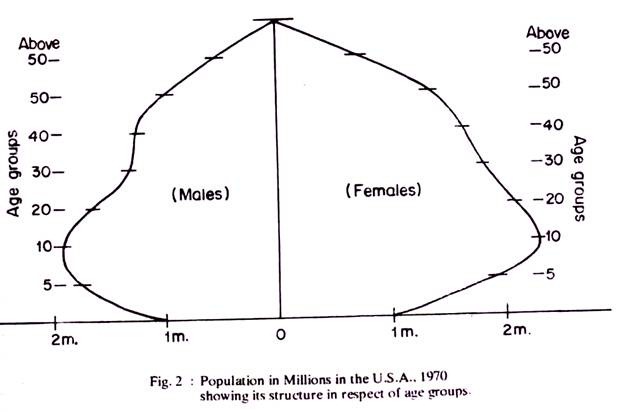Classification of Villages: 4 Categories
I. On the Basis of Structure:
Structurally villages in India can be divided into following types:
1. The Nucleated Village:
This is a common pattern of settlement mostly discernible in paddy growing areas. In this type of village, homes of farmers and artisans are clustered together.
ADVERTISEMENTS:
Their land is located outside the village at varying distance. Their livestock are often housed along with them or nearby them.
This type of villages are characterised by residential proximity, neighbourhood, community feeling etc.
2. The Linear Village:
In this type of village, houses are built on parallel rows. Each house is surrounded by small gardens. The paddy fields are at a distance from the house. This pattern of settlement unites the social advantage of residential closeness and economic advantages of living on one’s land.
3. Dispersed Village:The village in which the dwelling places of the village lay scattered or diffused is called a dispersed village. These villages have no definite structure or shape. This type of village is found in hilly areas.
4. The Mixed Village:
It is the mixer of nucleated and dispersed pattern of settlement. In this type of village settlement, there is a larger compact settlement of houses which is surrounded by a few small hamlets at a distance. This type of settlement can be seen both in plain as well as hilly areas.
II. On the Basis of Residence:
1. Migratory Village:
Here, people live for few months or for as season. They collect their rood from natural resources. But when the food supply from that place is lessened, then they shift to another I place where they can find adequate amount of food. For example, J we find this type of village among the tribal society i.e. shifting cultivation.
2. Semi-permanent Agricultural Village:
In semi- permanent agricultural villages, people reside for few years at a particular” place and migrate to another place due to the exhaustion of the productivity of land. The duration of residence is more as compared to migratory type of villages.
In this type of village, people keep animals like cow and goat but do not cultivate the land for agriculture. They burn down the small trees and bushes and sow seed over the earth which gives them some crop after rainfall. When the people find that land is not yielding required amount of food grains, they leave the place’ for another new settlement.
3. Permanent Agricultural Village:
In permanent agricultural village, people live permanently for generation to generation. They develop village organisations and social relations within their own village. Generally, they do not change their living place and place of cultivation. Here, in this villages, permanent households are created.
III. On the Basis of Organisation:
1. Co-operative Villages:
In this type of village, land is owned individually and people pull their resources together for common cultivation and farming. Generally, co-operative houses are organised to supply them their necessary commodities. Co-operative villages are also seen in India.
2. Semi-Collective Village:In such villages, land belong to the collective body. All means of production and resources are owned collectively. The people work together for production of food grains and other essential goods. For their consumption, they get their monthly or annual dues fixed according to the income of the village.
The income of villagers is not associated with the number of hours worked by members of a particular family. The families received their quota according to the numerical strength of the family.
3. Collective Villages:
In this type of village, the villagers live in a communal settlement where all property is collectively owned and all the arrangements are done on a collective basis. Members of the village only render their labour to the common pool and get all the necessaries of life like food, clothing, housing, education etc.
There is common dining hall, common store and Communal Kinder Garden in the village. The Old and disabled persons are also maintained from the common fund. As a whole, such type of village gives full security for the whole life of a person, his children and dependents.
IV. On the Basis of Land Ownership:
1. Land-Lord Villages:
In such villages, land is owned by individual family or a few number of families known as land-lords. The landlords possess all the rights over the land but give the land to the tenants. The land-lords also impose rent on the land which tenants usually pay.
Land lords give certain percentage of rent to the king or government and keep a good percentage for themselves. Such type of villages existed in India before the abolition of intermediaries in agricultural sector.
2. Ryotwari Villages:
In ryotwari villages, farmers are the owners of the land and they cultivate it. They directly pay the rent to the government without any intermediary. Such villages are known as ryotwari villages where land is owned by Ryots or Cultivators.
Source: Classification of Villages: 4 Categories (sociologydiscussion.com)




Comments
Post a Comment